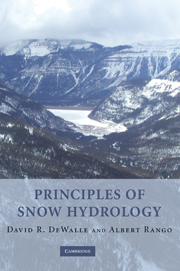Book contents
- Frontmatter
- Contents
- Preface
- 1 Introduction
- 2 Snow climatology and snow distribution
- 3 Snowpack condition
- 4 Ground-based snowfall and snowpack measurements
- 5 Remote sensing of the snowpack
- 6 Snowpack energy exchange: basic theory
- 7 Snowpack energy exchange: topographic and forest effects
- 8 Snowfall, snowpack, and meltwater chemistry
- 9 Snowmelt-runoff processes
- 10 Modelling snowmelt runoff
- 11 Snowmelt-Runoff Model (SRM)
- 12 Snowpack management and modifications
- Appendix A Physical constants
- Appendix B Potential solar irradiation theory
- Index
- Plate Section
- References
7 - Snowpack energy exchange: topographic and forest effects
Published online by Cambridge University Press: 18 August 2009
- Frontmatter
- Contents
- Preface
- 1 Introduction
- 2 Snow climatology and snow distribution
- 3 Snowpack condition
- 4 Ground-based snowfall and snowpack measurements
- 5 Remote sensing of the snowpack
- 6 Snowpack energy exchange: basic theory
- 7 Snowpack energy exchange: topographic and forest effects
- 8 Snowfall, snowpack, and meltwater chemistry
- 9 Snowmelt-runoff processes
- 10 Modelling snowmelt runoff
- 11 Snowmelt-Runoff Model (SRM)
- 12 Snowpack management and modifications
- Appendix A Physical constants
- Appendix B Potential solar irradiation theory
- Index
- Plate Section
- References
Summary
Introduction
Recent innovations in computing techniques and the need for modelling snowpack energy exchange processes for large diverse basins have lead to consideration of topographic and forest effects. Both topography and forests can have a major impact on snowpack radiation energy exchange. Effects on convective exchange are less well known. Methods for adjusting the basic theory of snowpack energy exchange for the effects of topography and forests are considered in this chapter. Topographic effects on precipitation and snow accumulation and forest effects on snow interception were previously discussed in Chapter 3.
Topographic influences
Topography controls the elevation, slope and aspect, and exposure of snowpack surfaces that can significantly influence energy exchange and melt across a watershed. Since many watersheds with significant snowpacks are quite mountainous, correction for the effects of topography becomes important when trying to develop spatially accurate models of snowmelt-runoff processes. Slope inclination and aspect angles modify the exchange of direct-beam and diffuse shortwave radiation and longwave radiation. Topographic relief can also lead to shading of surfaces by adjacent terrain. Precipitation amounts and types, wind speeds, temperatures, and humidities that are used in computing the energy budget for snowpack surfaces are also influenced by elevation and slope orientation. Snowpack exposure to prevailing winds and typical storm patterns can be influenced by topography and can greatly affect snowpack energy exchange. Lapse rates can be used to adjust temperature data for effects of elevation, but corrections for topographic effects on other meteorological parameters important to energy exchange are more problematical.
- Type
- Chapter
- Information
- Principles of Snow Hydrology , pp. 182 - 210Publisher: Cambridge University PressPrint publication year: 2008
References
- 1
- Cited by



